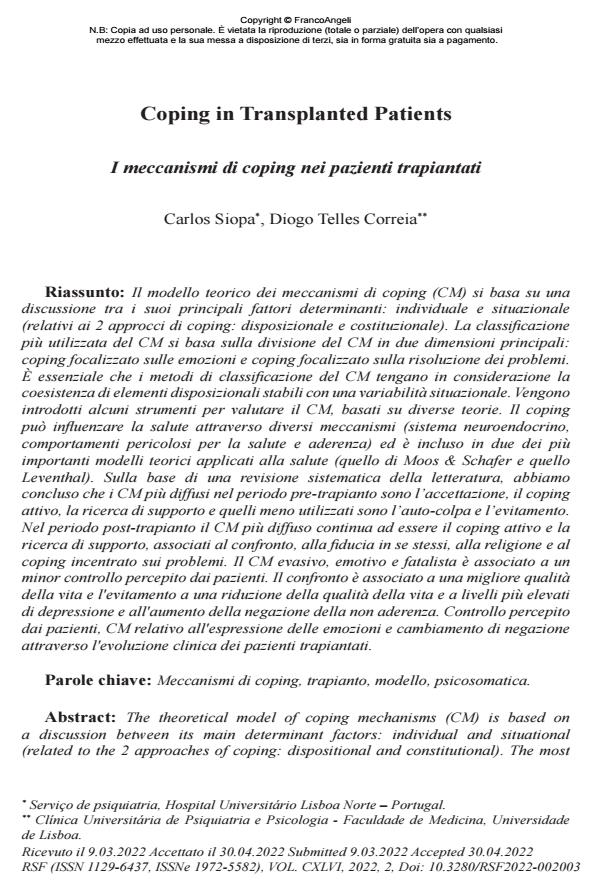Coping in Transplanted Patients
Titolo Rivista RIVISTA SPERIMENTALE DI FRENIATRIA
Autori/Curatori Carlos Siopa, Diogo Telles Correia
Anno di pubblicazione 2022 Fascicolo 2022/2
Lingua Inglese Numero pagine 15 P. 25-39 Dimensione file 161 KB
DOI
Il DOI è il codice a barre della proprietà intellettuale: per saperne di più
clicca qui
Qui sotto puoi vedere in anteprima la prima pagina di questo articolo.
Se questo articolo ti interessa, lo puoi acquistare (e scaricare in formato pdf) seguendo le facili indicazioni per acquistare il download credit. Acquista Download Credits per scaricare questo Articolo in formato PDF

FrancoAngeli è membro della Publishers International Linking Association, Inc (PILA)associazione indipendente e non profit per facilitare (attraverso i servizi tecnologici implementati da CrossRef.org) l’accesso degli studiosi ai contenuti digitali nelle pubblicazioni professionali e scientifiche
The theoretical model of coping mechanisms (CM) is based on a discussion between its main determinant factors: individual and situational (related to the 2 approaches of coping: dispositional and constitutional). The most used classification of CM is based on the division of CM in two main dimensions: coping focused on emotions and coping focused on problem resolution. It is essential that classification methods of CM have in consideration the coexistence of stable dispositional elements with a situational variability. Some instruments to evaluate CM are introduced, based on different theories. Coping can influence health through different mechanisms (neuroendocrine system, health threatening behaviours and adherence) and is included in two of the more important theoretical models applied to health (Moos & Schafer’s and Leventhal’s). Based on a systematic literature review we concluded that the most prevalent CM in pre transplantation period are acceptance, active coping, seeking support, and the less used are self-blame and avoidance. In post transplantation period the more prevalent CM continue to be active coping and support seeking, associated to confrontation, self-confidence, religion and problem focused coping. Evasive, emotive and fatalistic CM are associated to less control sensed by patients. Confrontation is associated to a better quality of life and avoidance to a reduction of quality of life and higher depression levels and denial to non-adherence increase. Control sensed by patients, CM related to the expression of emotions and denial change through clinical evolution of transplanted patients.
Il modello teorico dei meccanismi di coping (CM) si basa su una discussione tra i suoi principali fattori determinanti: individuale e situazionale (relativi ai 2 approcci di coping: disposizionale e costituzionale). La classificazione più utilizzata del CM si basa sulla divisione del CM in due dimensioni principali: coping focalizzato sulle emozioni e coping focalizzato sulla risoluzione dei problemi. È essenziale che i metodi di classificazione del CM tengano in considerazione la coesistenza di elementi disposizionali stabili con una variabilità situazionale. Vengono introdotti alcuni strumenti per valutare il CM, basati su diverse teorie. Il coping può influenzare la salute attraverso diversi meccanismi (sistema neuroendocrino, comportamenti pericolosi per la salute e aderenza) ed è incluso in due dei più importanti modelli teorici applicati alla salute (quello di Moos & Schafer e quello Leventhal). Sulla base di una revisione sistematica della letteratura, abbiamo concluso che i CM più diffusi nel periodo pre-trapianto sono l’accettazione, il coping attivo, la ricerca di supporto e quelli meno utilizzati sono l’auto-colpa e l’evitamento. Nel periodo post-trapianto il CM più diffuso continua ad essere il coping attivo e la ricerca di supporto, associati al confronto, alla fiducia in se stessi, alla religione e al coping incentrato sui problemi. Il CM evasivo, emotivo e fatalista è associato a un minor controllo percepito dai pazienti. Il confronto è associato a una migliore qualità della vita e l'evitamento a una riduzione della qualità della vita e a livelli più elevati di depressione e all'aumento della negazione della non aderenza. Controllo percepito dai pazienti, CM relativo all'espressione delle emozioni e cambiamento di negazione attraverso l'evoluzione clinica dei pazienti trapiantati.
Parole chiave:Meccanismi di coping, trapianto, modello, psicosomatica.
Carlos Siopa, Diogo Telles Correia, Coping in Transplanted Patients in "RIVISTA SPERIMENTALE DI FRENIATRIA" 2/2022, pp 25-39, DOI: